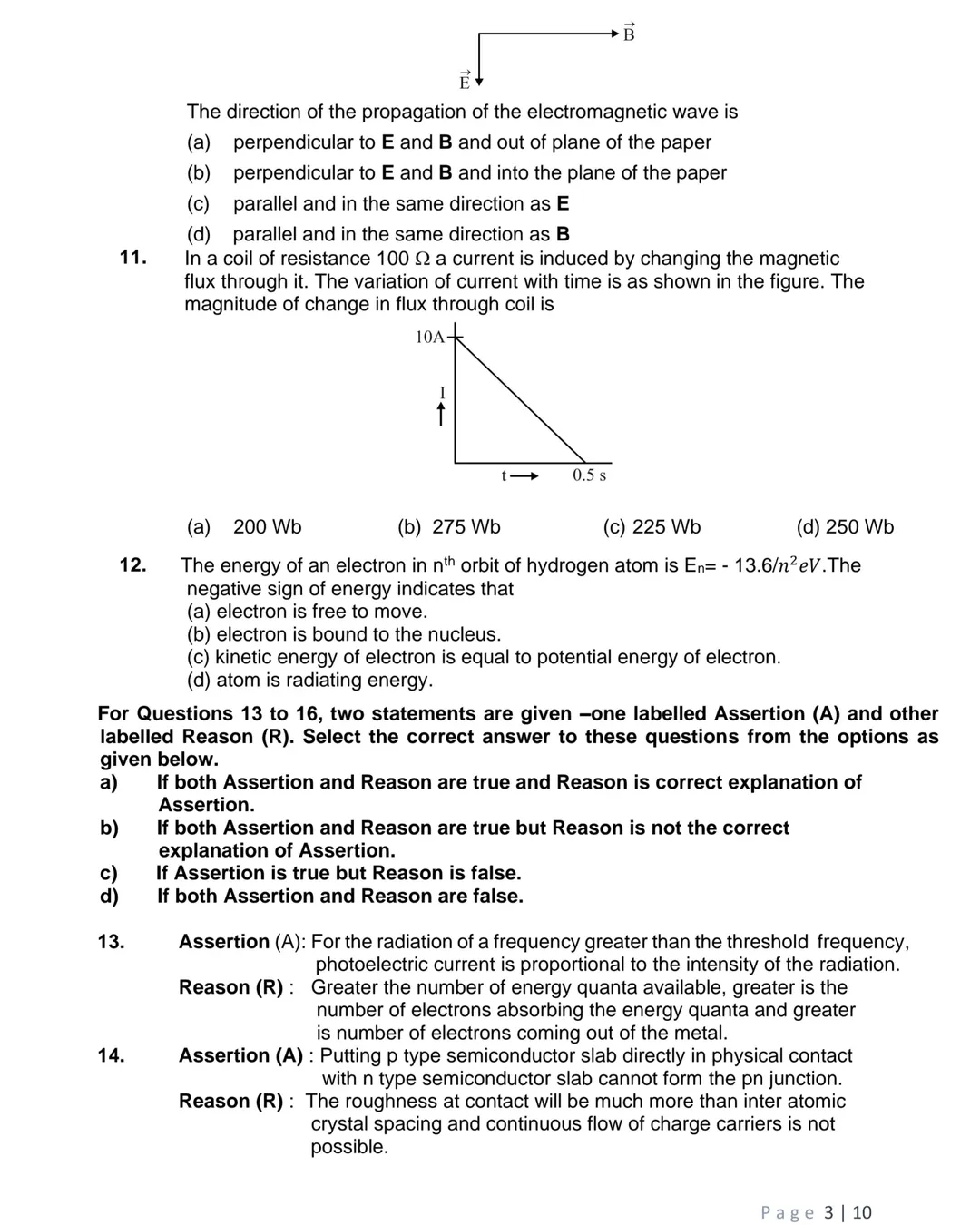1. The direction of the propagation of the electromagnetic wave is (a) perpendicular to E and B and out of plane of the paper (b) perpendicular to E and B and into the plane of the... 1. The direction of the propagation of the electromagnetic wave is (a) perpendicular to E and B and out of plane of the paper (b) perpendicular to E and B and into the plane of the paper (c) parallel and in the same direction as E (d) parallel and in the same direction as B 2. In a coil of resistance 100 Ω a current is induced by changing the magnetic flux through it. The variation of current with time is as shown in the figure. The magnitude of change in flux through coil is (a) 200 Wb (b) 275 Wb (c) 225 Wb (d) 250 Wb 3. The energy of an electron in nth orbit of hydrogen atom is En= - 13.6/n2eV. The negative sign of energy indicates that (a) electron is free to move. (b) electron is bound to the nucleus. (c) kinetic energy of electron is equal to potential energy of electron. (d) atom is radiating energy. 4. Assertion (A): For the radiation of a frequency greater than the threshold frequency, photoelectric current is proportional to the intensity of the radiation. Reason (R): Greater the number of energy quanta available, greater is the number of electrons absorbing the energy quanta and greater is number of electrons coming out of the metal. 5. Assertion (A): Putting p type semiconductor slab directly in physical contact with n type semiconductor slab cannot form the pn junction. Reason (R): The roughness at contact will be much more than inter atomic crystal spacing and continuous flow of charge carriers is not possible.

Understand the Problem
This appears to be an electromagnetism focused physics homework question. The first question asks about the direction of propagation of an electromagnetic wave. The second question involves calculating the magnitude of change in magnetic flux through a coil, given a graph of current versus time. The third question is about the energy of an electron in the nth orbit of a hydrogen atom. Questions 13 and 14 are assertion-reason questions.
Answer
1. (a) 2. (d) 3. (b) 4. (a) 5. (a)
- (a) perpendicular to E and B and out of plane of the paper
- (d) 250 Wb
- (b) electron is bound to the nucleus.
- a) If both Assertion and Reason are true and Reason is correct explanation of Assertion.
- a) If both Assertion and Reason are true and Reason is correct explanation of Assertion.
Answer for screen readers
- (a) perpendicular to E and B and out of plane of the paper
- (d) 250 Wb
- (b) electron is bound to the nucleus.
- a) If both Assertion and Reason are true and Reason is correct explanation of Assertion.
- a) If both Assertion and Reason are true and Reason is correct explanation of Assertion.
More Information
The direction of propagation of an electromagnetic wave is given by the Poynting vector, which is proportional to the cross product of the electric and magnetic fields (E x B). This direction is perpendicular to both E and B. The negative sign of the energy of an electron in an orbit indicates that the electron is bound to the nucleus. A p-n junction cannot be formed by simply placing a p-type and an n-type semiconductor in contact due to surface imperfections and contaminants.
Tips
Pay attention to the direction of E and B when determining the direction of propagation using the right-hand rule. Remember the formula (\Delta \phi = I*R) to calculate change in flux.
Sources
- shaalaa.com - shaalaa.com
AI-generated content may contain errors. Please verify critical information